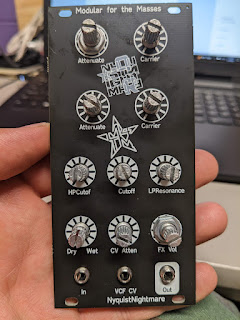This past weekend, I got to go to a flow-arts festival in Kentucky USA called PlayThink. This is my 3rd year, and it's always a blast. I had my synthesizer there, and allowed children and adults to play with it unsupervised without limit AND???? on the second day it broke. That's okay, I expected it to break much earlier, and also the malfunction is minor (power short, the power supplies just keep tripping).
"Children, you say!??" Yes! PlayThink is a sober festival, family-friendly, people bring their whole families with children of all ages. I danced and danced and danced, some of the time with a six-month-old baby (wearing active-noise-cancelling over-ear hearing protection) who was on their mother's back. What's up Anna, it was great dancing with you and your tiny baby haha
Hello Kitty Furiosa (my tin can synth in the picture) attracted lots of attention, even while broken. I got to pass out a bunch of 808 kick drum SynthCards (people love those!!!) and talk at length about the theory and practice of playing and building synthesizers.
The back of my synth is a total chaos-nightmare of criss-crossing wires, using at least two color-code schemes. I'll snip it all off, and run straight, taught wires, three each of red, black, and green, and connect each module to the wires with the old split-insulation-wrap-wire-around-larger-wire-solder trick. I won't even need to put tape around the join since the taught wires will be holding everything in place. I will make a cardboard shield or something to keep patch cables from dangling and touching the power rails although even that would just make a POP noise if the patch cable were plugged in to anything, wouldn't hurt anything. Or trip the power supply, which would make a longer POP and erase whatever I was doing...
ANYWAY, I'll pop a couple more pictures here of the festival. It was tons of fun, and I'm integrating the experience as well as one might expect.








